Choosing the right pickleball portable net can transform any flat surface into a pickleball court in minutes. This in-depth guide explores why portable nets matter, the different types available, and reviews the top models of 2025. We cover use cases, skill levels, budgets, setup and maintenance tips, industry trends, plus real user feedback. By the end, you’ll know exactly which portable pickleball net fits your needs. Let’s dive in!
![Portable pickleball net ready for play] Image: A collapsible portable pickleball net (Srikel FlashCourt) with wheeled base, illustrating easy outdoor setup.
Table of Contents
- Why Portable Pickleball Nets Matter
- Types of Portable Pickleball Nets
- Top Portable Pickleball Nets of 2025
- How to Choose the Right Portable Net
- Setup & Maintenance Tips
- Common Mistakes to Avoid
- Industry Trends in 2025
- User Stories & Testimonials
- Frequently Asked Questions
- Conclusion & Call to Action
Why Portable Pickleball Nets Matter
Portable pickleball nets dramatically expand where and when you can play. Since permanent pickleball nets are only available at dedicated courts, many players rely on portable nets for impromptu games. In fact, one source notes that “over 75% of the courts… don’t have a permanent net”, underscoring how crucial a portable net can be. With a portable net, any suitable flat space—from a tennis court to a driveway—becomes a pickleball court, so you don’t have to wait to play.
Portable pickleball nets are designed for both indoor and outdoor play, making them highly versatile and durable for use in a variety of environments.
More Courts, More Play
Portable nets effectively create new courts. As pickleball’s popularity soars, permanent courts are in high demand. In many communities, players find that local parks or gyms lack the nets needed. A portable net solves this: you simply lug the net bag out, assemble, and play. This flexibility means you can join games with friends anywhere, rather than hunting for the rare permanent net. It keeps the sport accessible and spontaneous.
Convenience & Flexibility
Convenience is a major advantage. Portable nets are designed for quick setup and teardown, letting you spontaneously start games. Many modern portable pickleball nets are easily disassembled, allowing for quick teardown and storage. Modern models can roll out in under a few minutes. A dedicated review highlights one net that “sets up in just 3 minutes,” while another Amazon user praised a $68 set for being “as stable…as any branded” and easy to assemble. Portable nets also pack down small, fitting into trunks or even large carry-on bags. This makes them ideal for people who move around—coaches, multi-sport facilities, and travelers alike.
Travel & Backyard Fun
Portable nets shine for backyard games, travel, and dual-sport use. Families can install one in the driveway or on a garage gym floor for a fun workout. Road-tripping players often bring a net to convert tennis courts or simple parking lots into pickleball venues on the go. Because many portable nets are lightweight (some under 20 lbs), they’re easy to load into cars or even check on planes.
Transporting portable pickleball nets is simple thanks to their lightweight and compact design, making it easy to move them between locations for setup or storage.
They let you play pickleball at a friend’s house, on vacation, or anywhere you have space. In short, if you ever want to play outside an official venue, a portable net is indispensable.
Types of Portable Pickleball Nets
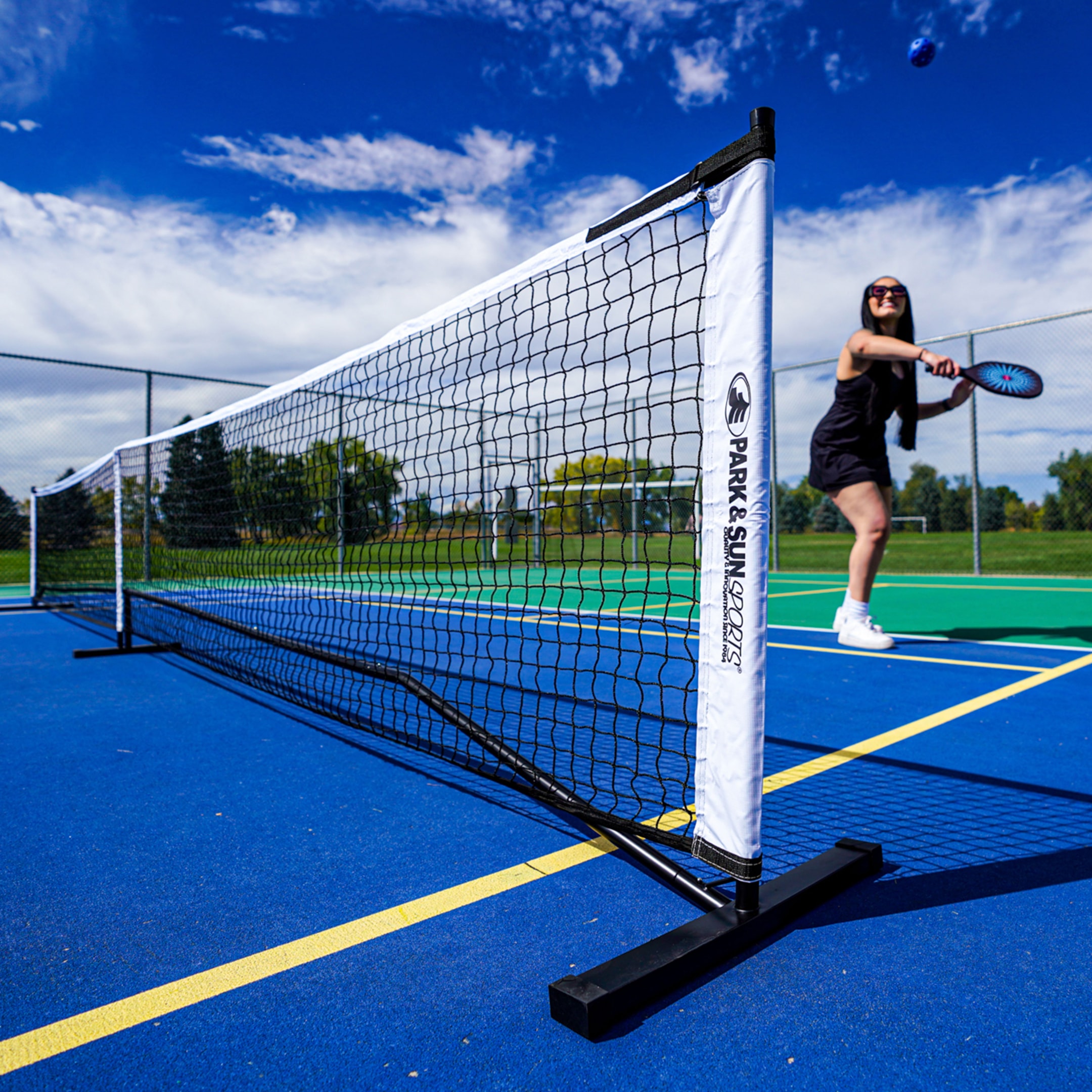
Not all portable nets are the same. Various net systems are designed to meet different needs for portability, stability, and ease of use. The main categories include frame nets (tension frames that unfold), tension strap/roll-out nets, and wheeled rolling nets. Understanding these types helps match a net to your priorities like weight, stability, and setup speed.
Collapsible Frame Nets
Frame nets use folding metal or composite tubes that snap or hinge into place. Examples include lightweight models from Srikel and OnCourt OffCourt. These often resemble mini-tennis nets: the frame pops open into shape, and the net attaches around it. They can be quick to deploy—Srikel’s FlashCourt net, for instance, claims a 60-second setup—and very sturdy once locked. However, frame nets tend to be heavier (often 30+ lbs) because of the metal. They usually come with a wheeled base to move them on-court. Pros: stable, often club-quality play. Cons: heavier, more parts to unfold.
Most collapsible frame nets also include a carrier bag for convenient transport and storage.
Roll-Out Tension Nets
Roll-out or strap nets are designed to spread across the court with minimal framing. A notable example is the SwiftNet 2.1, which has an innovative carbon-fiber brace. You simply roll these nets out, lock down a few poles, and attach a center strap. The net is raised slightly off the ground, allowing balls to roll underneath for easier collection. The SwiftNet 2.1 is only 17 lbs and can be set up in just a few minutes. It uses tensioned straps or braces to hold the net at official height (36” ends, 34” center). These nets emphasize lightweight portability. They’re easy to carry but may flex a bit under ball impact. Pros: extremely light and fast to set up, truly portable. Cons: may feel less rigid than a heavy frame, though top models are very good.
Wheeled Rolling Nets
Wheeled nets (like OnCourt OffCourt’s PickleNet) come with wide, wheeled bases that you roll into place. You typically clamp the net frame on these bases. They take more time to assemble, but they’re very stable once set. For example, OnCourt’s PickleNet Deluxe uses oval tubing and weighs about 42 lbs with its bag, but the wheels make it easy to move. Some wheeled sets can include extras (court markers, paddles). Pros: extremely stable, often patent-designed for no-sag and alignment. Cons: heavier to carry and set up.
Be sure to compare wheeled rolling nets with other types of pickleball nets to determine which option best fits your needs.
Compact & Half-Court Nets
Some portable nets are designed for tight spaces or training. A popular format is a 2-in-1 set that includes a full 22-ft net and a shorter 11-ft net for half-court practice. The BAGAIL set, for instance, offers both sizes plus a ball collector. Some bundled sets also include wooden paddles, but these are less durable than modern paddle materials and may not offer the same playability or longevity. These are great for driveways or drills, but have a few more parts. There are also very compact practice rebound nets (for solo play), but this guide focuses on full/half-size nets. In general, net designs vary from full-regulation sets to quick training nets, so be sure the model you pick fits how you’ll play (singles drills, kids games, etc.).
Top Portable Pickleball Nets of 2025
Below are detailed reviews of our top portable net picks for 2025. These reviews highlight the best pickleball nets available in 2025, focusing on quality, portability, and value. Each model is compared by features, pros/cons, and ideal users. We cover a range from lightweight travel nets to heavy-duty club nets.
Srikel FlashCourt Portable Net
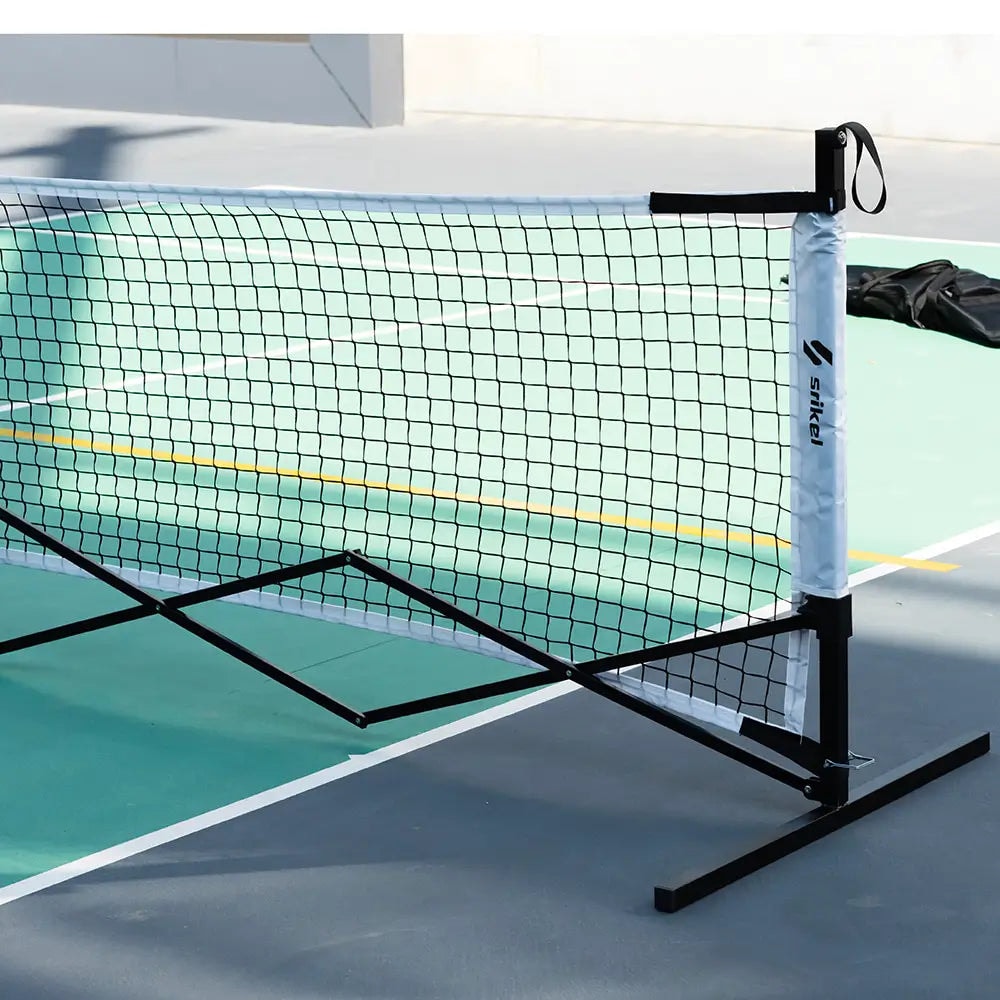
The Srikel FlashCourt is a premium collapsible net system known for its great quality, combining speed and durability. It uses a sturdy powder-coated steel frame with a wheeled rolling base.
Features
-
Ultra-fast setup: Pops open into shape and locks in seconds (advertised 60 sec assembly).
-
Lightweight frame: Weighs just 26 lbs, lighter than many metal-frame nets.
-
Wheeled base: Two large wheels on the base for easy repositioning on the court. No carrying strap needed.
-
Regulation size: Official USAPA dimensions (36" tall ends, 22' wide) with a center strap to maintain 34" mid-height.
-
Built for weather: Powder-coated steel resists rust; carries a 1-year warranty. Includes a sturdy carrying bag.
Pros & Cons
-
Pros: Very fast one-person setup; solid steel construction means minimal sag or wobble; wheels make transport easy. Top-tier build quality (“no droopy spots”) impressed users.
-
Cons: Higher price (~$199) than simple nets; heavier than ultra-light models (not for backpack travel). Setup is fast, but you still need a few clicks – not literally push-and-click like a roll-out net.
Who Should Buy It
Srikel’s net is ideal for serious recreational players who want a quick, no-fuss setup and pro-level stability. If you’re setting up courts frequently (weekend mixers, practices), this net lets you roll in and play almost instantly. It’s also great for those who may not want to wrestle a sagging net – Srikel users report excellent tension and alignment. In short, if convenience and quality are top priority and budget isn’t an issue, Srikel’s FlashCourt delivers.
OnCourt OffCourt PickleNet Deluxe
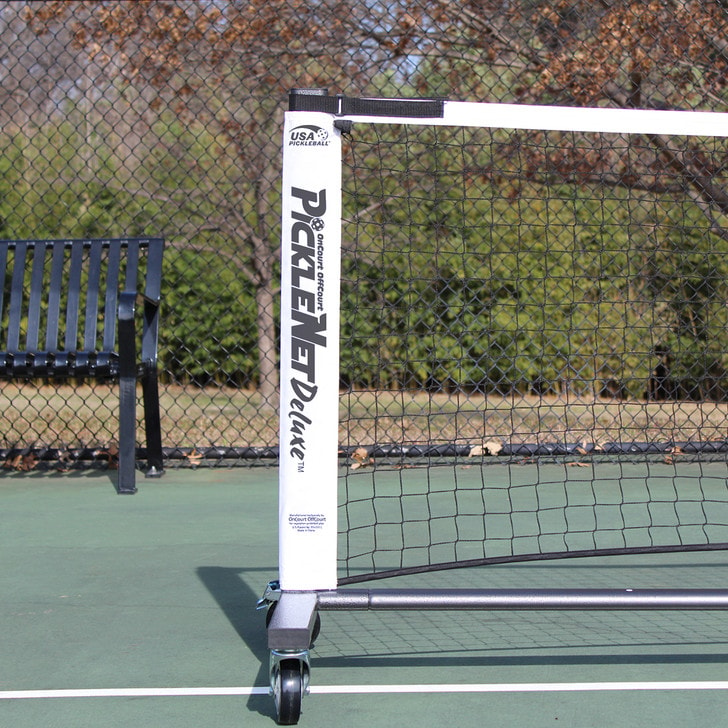
OnCourt OffCourt’s PickleNet Deluxe is a heavy-duty, club-level portable system built for stability. It features patented oval tubing and a dual-base design.
This net is also ideal for use in a pickleball facility, thanks to its stability and professional features.
Features
-
Oval tube frame: 1.5"x3" oval steel/aluminum tubing ensures the frame is twist-free, keeping it “straight & stays straight”.
-
Hybrid materials: More than 50% aluminum (frame joints and rails) plus heavy steel bases (together ~42 lbs total with bag).
-
Lockable wheels: 4" caster wheels on each of the two base units, easy to lock or roll for placement.
-
Anti-sag system: Center base with heavy strap plus five tension straps on net edges keeps height consistent.
-
Regulation spec: Official size (22'×36"/34") with center strap; instructions advise indoor storage to prevent rust.
-
Portability: Comes with a rugged 420D nylon wheeled bag with compartments (for poles, net). Heavy-duty zipper and handles.
Pros & Cons
-
Pros: Extremely stable play – very little movement when hit. Wheels and bag make it reasonably portable on hard surfaces. The tension system yields a near-permanent-net feel. Built by the original USAPA partner, it’s a professional-level net (many clubs use it).
-
Cons: Not quick to assemble – expect
10–15 minutes for set up (you have multiple poles and pins). It’s the bulkiest of the bunch, so best suited for a permanent court conversion or dedicated facility. Price is high ($460), so it’s an investment typically reserved for serious hosts or clubs.
Who Should Buy It
The PickleNet Deluxe is for clubs, gyms, and dedicated players who want the stability of a permanent net in a portable package. If you manage a facility or enjoy top-tier play, the Deluxe’s premium features will impress. The net’s heaviness and assembly time mean it’s less ideal for casual solo players. But for weekly league use or events where you want consistent performance, it’s a gold standard. Its “locking wheels” and sandbag-ready design also means it works outdoors in wind better than most.
A11N 22ft Professional Net
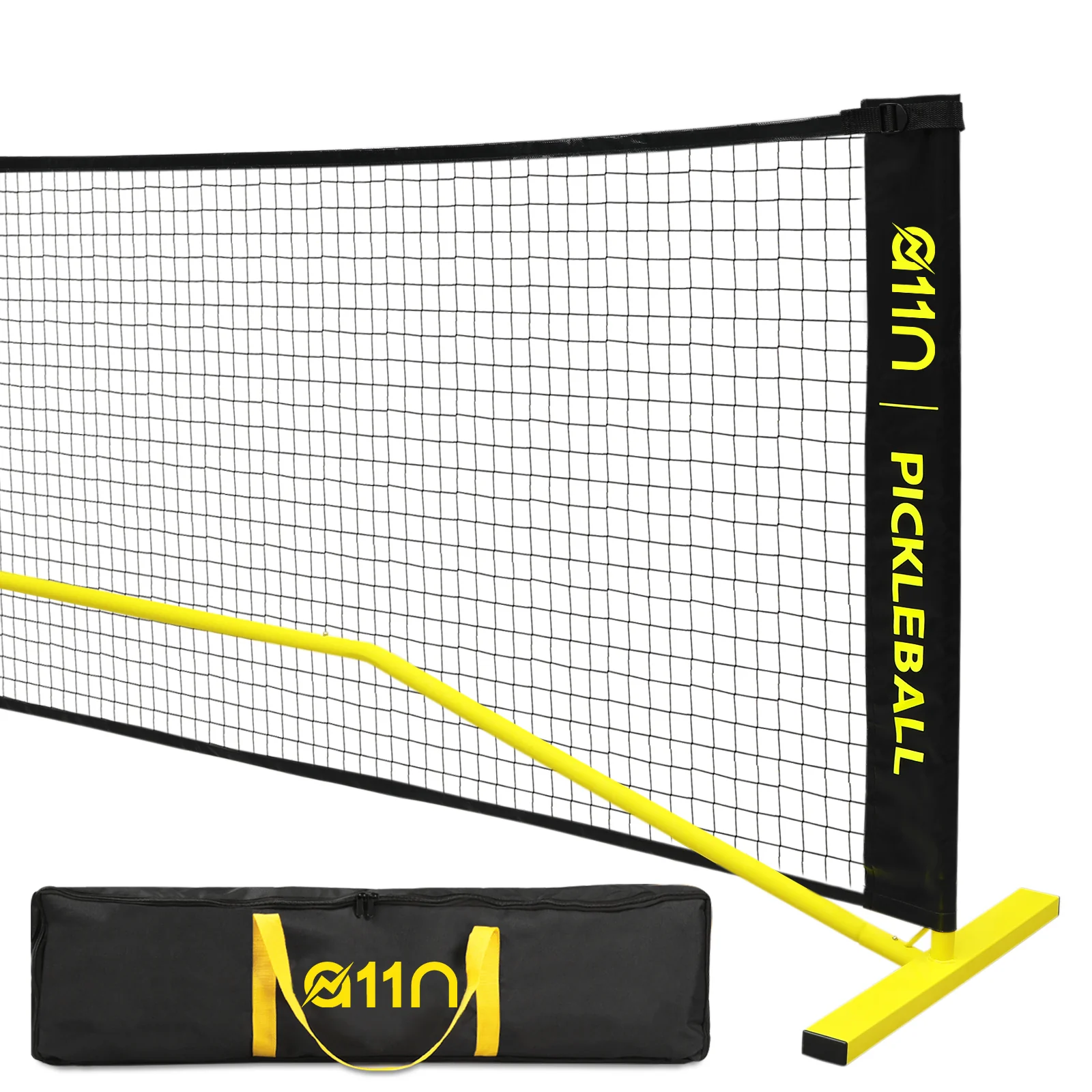
The A11N Pro is a durable net with a robust metal-frame system, specifically designed for high-frequency play. It’s designed to mimic club nets but still be portable.
Features
-
6 caster wheels: Each base leg has a lockable wheel, allowing one-person movement of the entire net.
-
Hand-crank tension: A winch on the side lets you fine-tune net tension, keeping it tight and straight (no sag).
-
Heavy-duty frame: Thick steel frame with wide, bent legs for stability. The set comes with two sandbag pouches for extra anchoring.
-
Regulation specs: Official dimensions (22'×36"/34") with a steel center rod and tension straps.
-
Price point: Around $200 (on sale) which is a steal for a net of this quality.
Pros & Cons
-
Pros: Built like a club net; users love its rigidity and durability. The wheels and lock-in-place feature earn praise (“easy to move, thanks to the six caster wheels”). The winch tensioner makes play feel like a permanent court. Very high value for the price.
-
Cons: Setup time is long (about 1–1.5 hours total) because of all the pieces, so it’s not portable in the quick-setup sense. It’s heavy and cumbersome to store or lift, though once assembled you usually leave it partly assembled until season’s end. Not ideal for casual pop-up games.
Who Should Buy It
This net fits tournament hosts, clubs, and very serious players who demand pro-level performance at a budget-friendly price. One reviewer says, “if money is no object… Joola is best, but if you want club-level without the $2000 price tag, this A11N net is amazing”. It even comes with a 12-month warranty on the frame. If you plan to use a portable net all the time (like storing permanently on your property), the A11N Pro provides excellent play quality for ~the cost of a nice paddle. In short, get this if durability and professional feel are your top priorities.
SwiftNet 2.1
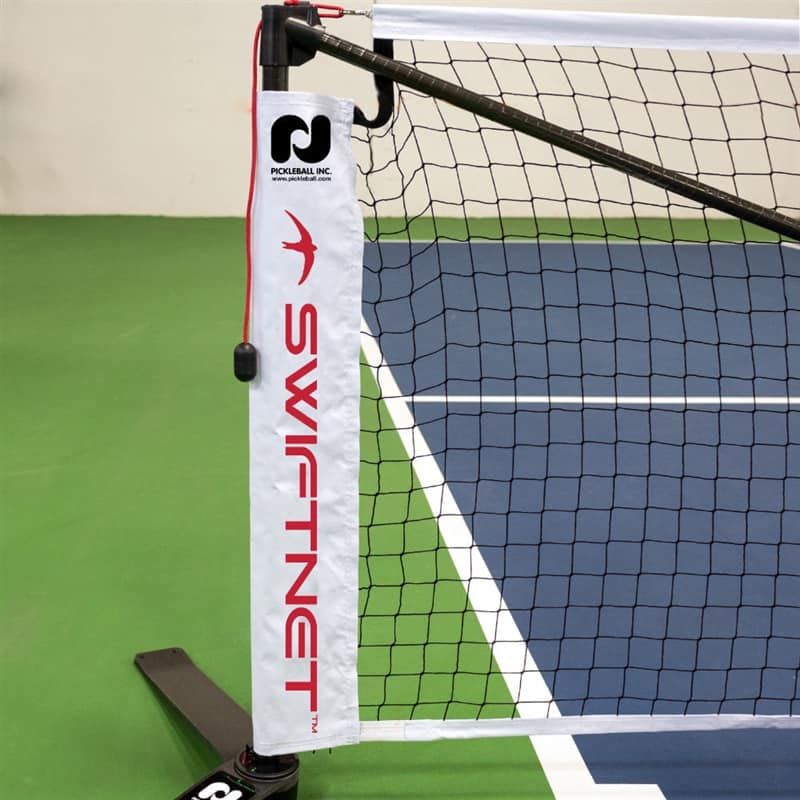
The SwiftNet 2.1 is a state-of-the-art roll-out net that emphasizes extreme portability. It uses lightweight materials to achieve professional net height with minimal frame. The SwiftNet 2.1 also performs exceptionally well as a net indoors, maintaining stability and proper tension even without wind, making it comparable to a permanent court installation. It is considered the best overall portable pickleball net due to its blend of weight, setup time, and durability.
Features
-
Ultra-light carbon/aluminum frame: Only 17 lbs total weight. The legs are rust-resistant aluminum, and the center brace is recycled carbon fiber.
-
Locking tension system: Supports net height with a patented locking brace at midcourt. When assembled, the net is held at exactly 34" center (36" ends).
-
Rapid setup: Pop open the collapsible frame and roll the net, and you’re done – about 3 minutes from box to play. No tools needed.
-
Travel-friendly: Folds down to fit in its small carry bag. Many players travel with it on pickleball trips or to courts that need conversion.
-
Eco-friendly design: Emphasizes sustainability (brace uses recycled carbon fiber, net is durable vinyl). Includes extra pull cords and a padded carry case.
Pros & Cons
-
Pros: Unbeatable for weight and portability. Users praise it as “light and stable” with “great tension”. It truly feels closer to a permanent net than any other roll-out design. SwiftNet’s build quality and quick deployment are highly rated by frequent users.
-
Cons: High cost (~$370 retail, sometimes discounted to ~$300). Since it’s so lightweight, it’s not as inherently stable as the wheeled club nets; it can wobble if not tensioned properly (but many say it still beats cheaper nets). Also, being a premium niche product, warranty/support matters, so buy from a trusted source.
Who Should Buy It
SwiftNet is perfect for players on the move. If you road-trip to different courts, coach clinics, or often play away from home, its featherlight design is a game-changer. Many Reddit users say “Swiftnet is the best of the portable nets” and worth the investment if you’ll use it regularly. Its travel bag fits as checkable luggage, so tournament-goers love it. It’s also great for families that want to tote a net easily. Beginners could use it too, but the full cost means it really shines for those who maximize its portability daily.
BAGAIL 22ft Portable Net Set (with Wheels)
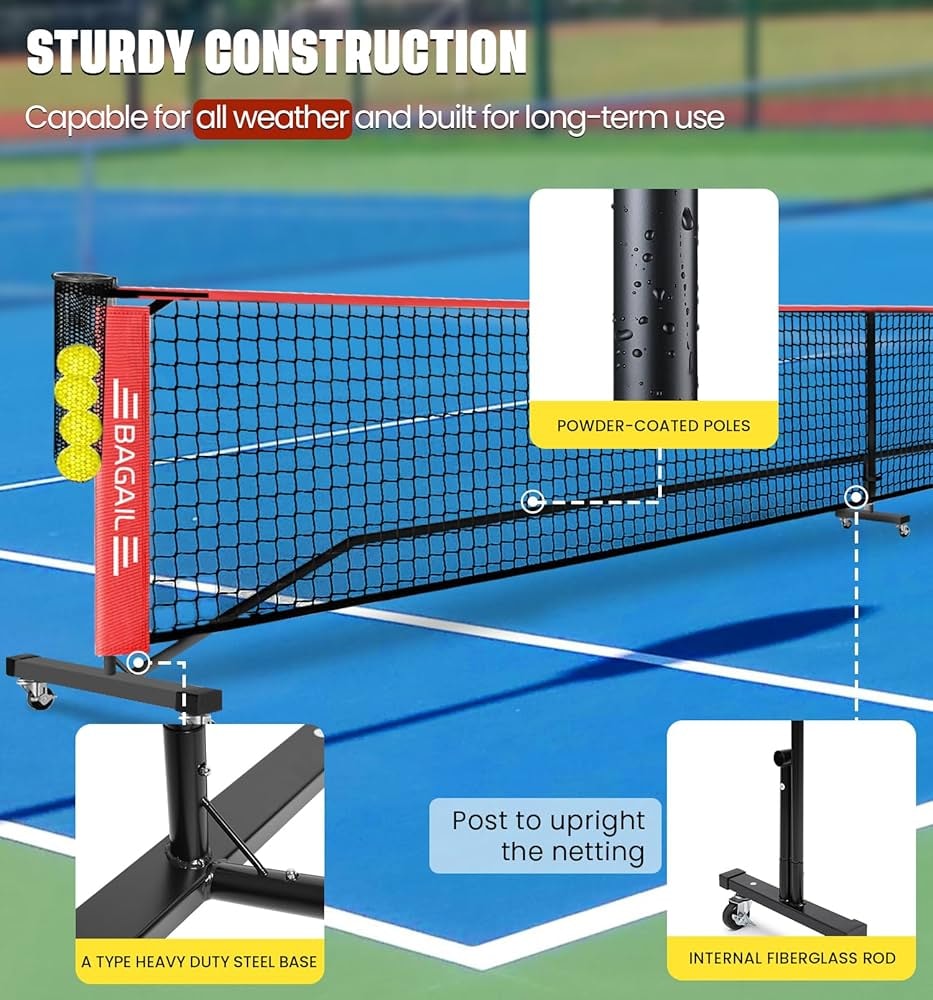
The BAGAIL 22ft set is a budget-friendly, multi-piece net system often sold in bundles. It includes a full-size regulation net plus extras. While designed for portability, the BAGAIL set can also serve as a semi permanent net for those who want to leave it set up for longer periods, making it suitable for outdoor use or dedicated play areas.
Features
-
Two nets included: One full 22ft regulation net (36"×22ft) and one 11ft half-court net. This 2-in-1 design supports both full games and quick drills.
-
Ball collector kit: A unique accessory that hangs on the net to catch balls, keeping them in reach during drills. Handy for training or kids.
-
Heavy-duty netting: Uses reinforced 8-ply PE net material that can handle power hits.
-
Sturdy poles: Powder-coated 0.8mm metal poles with a steel center rod prevent sagging. Net edges have adjustable straps for tension.
-
Easy assembly: Push-lock style connections (parts numbered) let one person assemble in minutes. No extra tools needed.
-
Compact bundle: Comes with a 600D oxford carry bag, a few paddles and balls (as a set), and sometimes court-line markers.
Pros & Cons
-
Pros: Value-oriented—often under $80 for the whole kit (sometimes two nets for ~$75). You get a lot of gear (nets, balls, bag, paddles) in one purchase. Good for beginners or families. The ball collector and half-net are fun training tools. People report it feels surprisingly stable for the price.
-
Cons: Not as rigid as higher-end models. The frame can flex, and assembly pieces are mostly plastic connectors (not the most durable). It can swerve a bit in wind. This is very much a budget set – think of it as a starting net, not a pro net.
Who Should Buy It
The BAGAIL set is aimed at casual players, families, and beginners on a budget. If you want to try portable pickleball without spending a lot, this set lets you start full-court and half-court play immediately. It’s perfect for a household purchase (kids love the ball collector!), or for someone who just wants a backup net. Just keep expectations realistic: it will give you years of fun, but it will eventually show wear if used heavily. As one Reddit user suggested, it's a “steal”for the price when on sale.
How to Choose the Right Portable Net
Selecting the best portable net depends on how you’ll use it. Choosing the right portable net system involves considering factors like ease of setup, portability, and durability to ensure it meets your needs for different playing environments. Consider where you’ll play, how often, your skill level, and your budget. Here are key factors to weigh:
By Use Case
-
Backyard/Driveway Games: Look for easy setup and breakdown. A roll-out net (like SwiftNet) or a quick-frame net (like Srikel) is ideal. If you only play outdoors casually, a medium-duty net with wheels (A11N or OnCourt) adds stability.
-
Tournaments/Clubs: You’ll want the most consistent play. A permanent pickleball net offers the most consistent play experience, but a heavy-duty frame net (A11N Pro or PickleNet Deluxe) will closely mimic this for portable setups. These nets also often comply precisely with USAPA standards (22ft width, 36”/34” height).
-
Travel/Events: Prioritize weight and packability. The SwiftNet 2.1 excels here, as do any nets specifically advertised as “travel” versions.
-
Kids & Training: Features like half-court nets, ball holders, and paddles (found in bundles like BAGAIL or Tyrsen) make training easier. Durability matters too—cheap nets break after a few uses if overstressed. Mid-range frame nets can handle kids’ rough play.
By Skill Level
-
Beginner: You can start with almost any net that’s regulation height. Budget nets (BAGAIL, basic Amazon sets) often suffice for learning.
-
Intermediate: As you progress, a sturdier net (Srikel, A11N portable) will improve play feel. Intermediates often want a balance of ease and quality.
-
Advanced/Pro: Serious players will not compromise on net performance. They should choose a stable, regulation net. The top recommended nets (OnCourt Deluxe, A11N Pro) have minimal movement. Also look for nets that meet USAPA specs precisely. Advanced players may also prefer high-quality pickleball systems that are built for durability, weather resistance, and compliance with official standards.
By Budget
-
Under $100: You’ll find mostly pop-up or Amazon-brand sets (like ZENY or similar). These can work but often sag or break more easily. The BAGAIL set (often < $80 on sale) is a good pick. At this range, expect to replace the net or connectors after a year of heavy use. The ZENY Portable Pickleball Net is regarded as the best full-size net for under $100.
Remember also to factor in accessories: some nets come with balls, line markers, and paddles (like the Tyrsen or CourtOwl sets). If you need a full kit, sometimes bundling is cheaper than buying pieces separately.
Setup & Maintenance Tips
Even the best net needs proper care and setup for optimal performance. Follow these tips to get the most out of your portable net.
For outdoor use and long-term durability, choose a rust proof net, as it can withstand wind and rain without rusting.
Setting Up Your Net
-
Choose a flat surface. Portable nets work best on smooth, level ground (tennis/basketball courts, asphalt driveways). If the ground is uneven, the net may lean or sag.
-
Unfold the frame correctly. With frame nets (Srikel, A11N), ensure all legs are fully extended and locked before attaching the net. For roll-out nets (SwiftNet), pop open the side braces fully.
-
Attach the net tensioners. Most nets have straps or cords at the edges. Adjust these to remove any sag. For example, attach the center strap first to set mid-net height (34”), then tighten side straps. The A11N’s winch handles this automatically, but on other nets you’ll need to tie or clip them manually. Higher-quality portable nets often feature high-tensile top cords to maintain tension and prevent sagging.
-
Secure the bases or feet. If your net has wheeled or weighted feet, lock them in place so they can’t roll. If it has ground spikes or stakes (less common), hammer them in for stability. In windy conditions, use sandbags or anchor weights if available (some heavy-duty nets include sand bag attachments). If you are setting up near a chain link fence, some portable nets can be stabilized by attaching them directly to the chain link fence for extra support.
-
Check height & tension. Measure at center: should be 34”, and 36” at the posts. Adjust tension until balls just roll under the net with a firm push. A net that’s too tight or too loose will affect play.
Caring for Your Net
-
Store indoors: Do not leave the net assembled outside overnight or in bad weather. Even rust-resistant frames can corrode with exposure. OnCourt OffCourt explicitly warns nets are not “rust proof” and recommends storing everything indoors.
-
Dry it if wet: If you play in dew or rain, dry the net and frame before packing away. Moisture can weaken materials over time.
-
Clean gently: Use a damp cloth to wipe off dirt or grass. Avoid harsh chemicals. If the net fabric is sagging or greasy, a mild soap wash and air-dry can refresh it.
-
Inspect hardware: Periodically check that pins, screws, and joints are tight. Loose pieces can make nets unstable. Lubricate any moving parts (like wheel casters or buckles) if they start to jam.
-
Repair small issues: Most nets allow replacing the netting or poles cheaply. Save the receipt or warranty info. For example, Srikel offers spare parts kits and a 1-year warranty.
Doing this extends the net’s life and ensures every game feels right.
Common Mistakes to Avoid
-
Skipping anchor/stabilizer: Even if it’s breezy, anchor the net. Forgetting sandbags or tension straps can lead to the net tipping or sagging during play.
-
Improper teardown: Always loosen tension straps before folding. Trying to collapse a net under tension can warp the frame.
-
Dragging the net: Don’t drag bases or poles across rough ground – lift or wheel it. Scratches can weaken the frame.
-
Overlooking wear: If you notice cracks in plastic connectors or frayed netting, fix them before the next game. Small breaks often get worse quickly.
-
Wrong net size: Ensure you pick a regulation-height net unless you know you only want half-court play. Kids’ nets exist, but they’re rare. A too-low net can hurt your game development.
By minding these points, you’ll avoid headaches and keep games running smoothly.
Industry Trends in 2025
The pickleball world is evolving fast. Here are some trends shaping portable nets and the broader scene in 2025:
Smart & Connected Gear
Technology is creeping in. While not yet common in nets, we see AI and sensor integration emerging in pickleball. For example, smart paddles and apps can analyze your swing. In the future, portable nets might even have built-in sensors or apps to track rallies or ball speed. Already, some companies are experimenting with electronic line-calling or VR training where portable nets play a role. Expect more tech-enhanced features (like clips for smartphone mounts or net-mounted cameras) soon.
Multipurpose Courts
As demand for courts soars, more venues are converting spaces into pickleball-friendly zones. Tennis or basketball courts now often have holders for portable pickleball nets. One report notes “Modular court solutions – portable nets and adaptable surfaces – make it easy to switch between sports”. This means portable nets will become even more ubiquitous, as multi-use gyms and parks accommodate different games. Look for portable nets that can double as volleyball or badminton nets with minimal fuss.
Sustainability & Innovation
Eco-friendly materials and design are getting attention. Manufacturers are using recycled composites and sustainable packaging. For instance, SwiftNet markets its carbon-fiber brace as recycled. Industry analyses note that UK customers are demanding “eco-friendly materials and recyclable packaging” in pickleball gear. Expect more companies to tout biodegradable nets or frames made from recycled metal alloys. This shift benefits the environment and caters to conscious consumers.
In summary, portable nets aren’t going away—in fact, they’re integral to pickleball’s explosive growth. The gear is getting smarter, courts are getting adaptable, and companies are innovating on materials. All of this means even better portable pickleball experiences for players by 2025 and beyond.
User Stories & Testimonials
Hearing from real players can be enlightening. Here are quotes from pickleball enthusiasts about their portable nets:
-
Lightning-fast setup:“This net blew me away. I’ve tried quite a few… but this one just nails it. The setup time is wild – about 2 minutes to assemble… teardown is 1 minute 24 seconds”. (Refers to the Srikel FlashCourt net.)
-
Pro-level play:“It felt like a professional pickleball net… the ball can also travel under the net near the middle, so it’s easy to pick up stray balls”. (Review of the A11N Professional net.)
-
Value at low cost:“I bought [an Amazon set] for $68 and it is as stable … as any of the branded ones I’ve seen. I was impressed for the price”. (Surprise stability of cheap nets.)
-
SwiftNet praise:“SwiftNet has great tension on the net. Lightweight too.” – Many users say this net “plays so much better” than generic nets.
-
Summary advice:“If you want the absolute best combo of quality and ease, go with the Srikel. Want value? A11N has you covered. On a tighter budget? Bagail is a smart buy. Many players look for the best pickleball equipment for their needs, especially when choosing top-rated nets.”
These testimonials highlight that a fast setup (Srikel), solid play feel (A11N), or good value (bag sets) can drive satisfaction. It shows there’s no one-size-fits-all: different nets shine for different priorities.
Frequently Asked Questions
Q: What is a portable pickleball net and why use one?A: A portable pickleball net is a net system you can set up anywhere (driveway, court, etc.) without permanent posts. They’re useful because many courts lack nets, so you can bring your own and play. Over 75% of pickleball courts in one survey didn’t have a net. Portable nets let you play on basketball courts, indoor gyms, or your backyard – essentially making any flat space a pickleball court.
Q: Are portable nets regulation size?A: The best portable nets meet official dimensions (22 feet wide, 36 inches high at the posts, 34 inches at center). All top recommendations here (Srikel, A11N, OnCourt, etc.) adhere to USAPA regulations. Most of these nets comply with USA Pickleball official regulations for size and materials, ensuring they are suitable for regulation play. However, always check product specs. Some cheap nets for kids might be smaller. Most portable pickleball nets are regulation size, measuring 22 feet wide and 36 inches high at the sidelines, 34 inches high in the middle.
Q: How do I set up a portable net quickly?A: It depends on the design. For roll-out nets (like SwiftNet), you typically unfold the frame and roll out the net strap—it can take only 1–3 minutes. For frame nets (A11N, Srikel), unfold the poles, snap them into the base or brackets, attach straps, and tighten. Even these usually take 5–10 minutes once you’re practiced. Always follow the included instructions and make sure all clips/locks are secure. Lock any wheels and tighten tension straps for best result.
Q: Can portable nets be used in official tournaments?A: Standard tournaments require fixed nets, not portable ones. However, many non-professional tournaments or leagues allow portable nets if they meet size rules. Many portable nets are designed to meet USA Pickleball standards for recreational and tournament play. The main difference is the net doesn’t have to be permanently installed in the ground. That said, portable nets like the A11N Pro or PickleNet Deluxe offer tournament-quality performance.
Q: How do I protect my portable net in wind?A: Use any provided anchors. Heavy-duty nets often come with sandbag attachments. Even if not provided, you can place sandbags or weights on the bases. Tightening all tension straps fully will also help keep the net upright. In very high winds, it may still topple – pick up stray nets when not in play to avoid damage.
Q: Are wheels important for a portable net?A: Wheels make a net much easier to move around once assembled. If you’ll be dragging the net on a hard court, wheels are very convenient. However, wheels add weight and complexity. Lightweight nets often skip wheels. Decide if mobility on court (lockable wheels) is worth the extra pounds for your use.
Q: How much do portable nets weigh?A: It varies widely. Roll-out nets like SwiftNet can be as light as ~17 lbs. Basic frame nets might weigh 30–40 lbs. Heavy-duty steel nets (A11N Pro with wheels) can be 50+ lbs assembled (but you wheel them rather than carry). Portable pickleball nets generally weigh between 17 lbs and 42 lbs depending on the model. Always check weight if you plan to transport it regularly.
Q: How do I maintain tension on a portable net?A: Most nets have tension straps or cords. After you put the net up, pull each side strap tight and lock it in place. The A11N Pro uses a hand-crank winch to tighten the center cord. Ensure the bottom elastic band on the net is hooked securely to the bases (if provided). Proper tension prevents sagging.
Q: What’s the best net for travel?A: SwiftNet 2.1 is a top choice for travel due to its light weight (17 lbs) and compact bag. Srikel FlashCourt is also fairly portable (26 lbs) with wheels for easy moving. Look for nets explicitly marketed as “portable” or “travel.” Avoid heavy wheeled bases if you plan to carry it in a car or plane.
Q: How often should I replace my portable net?A: With normal use, a well-made net can last several years. Inspect it yearly: replace the netting if it wears or tears, and check that frame parts aren’t bent. Cheap nets may need replacement faster; durable nets like Srikel or A11N last much longer. If any component breaks, many brands sell replacement parts (net fabric or poles).
Conclusion & Call to Action
Portable pickleball nets open up a world of play, from neighborhood driveways to impromptu courts at the park. With this guide, you now know why they matter, the types to consider, and the top nets to buy in 2025. Whether you want the lightning-fast setup of the SwiftNet, the rock-solid feel of the A11N or OnCourt Pro, or a value bundle like BAGAIL, there’s a perfect net for you.
Ready to elevate your game? Explore Forwrd’s pickleball gear and net recommendations to find the best portable net for your play style. Get your portable pickleball net today and start playing anywhere!
Introduction: The Rise of Portable Pickleball Nets
Pickleball has quickly become one of the fastest-growing sports in the world, captivating players of all ages with its unique blend of fun, fitness, and friendly competition. As more people discover the excitement of pickleball, the need for flexible playing options has skyrocketed. Enter portable pickleball nets—a game-changer for anyone who wants to play pickleball beyond traditional courts. These portable nets allow you to set up a game almost anywhere, from local parks and community centers to your own driveway or backyard. With a portable net, you’re no longer limited by the availability of permanent pickleball nets or dedicated courts. Whether you’re looking to enjoy a quick match with friends, organize a neighborhood tournament, or simply practice your skills, portable pickleball nets offer the perfect solution for on-the-go play. In this article, we’ll dive into everything you need to know about portable nets, including their benefits, essential components, and tips for choosing the best net for your pickleball adventures.
What is Pickleball? (New)
Understanding Net System Components (New)
Frame Materials & Design
The frame is the backbone of any portable pickleball net, providing the structure that keeps the net upright and at the correct height. Most portable pickleball nets feature frames made from lightweight yet sturdy materials like aluminum, steel, or a combination of both. Aluminum frames are popular for their light weight and resistance to rust, making them ideal for outdoor play and frequent transport. Steel frames, on the other hand, offer extra strength and stability, which is especially valuable for competitive or high-traffic settings. Look for a portable pickleball net with a frame that’s easy to assemble and disassemble, with secure locking mechanisms and a compact design for hassle-free storage and transport. A well-designed frame ensures your net stays steady during intense rallies and stands up to repeated use, whether you’re playing on concrete, grass, or indoors.
Net Fabric & Tensioning
The net fabric is another critical component, as it must withstand the rigors of regular play and exposure to the elements. The best portable pickleball nets use durable, weather-resistant materials such as high-density polyethylene or reinforced nylon, which resist tearing and sagging over time. Equally important is the net’s tensioning system, which keeps the net tight and at the proper height throughout your game. A quality tensioning mechanism should be easy to adjust, allowing you to quickly set the net to regulation height and maintain consistent tension during play. Look for nets with strong, reinforced edges and secure locking straps or winches that prevent sagging, so you can focus on your game without constant readjustments. Durable materials and a reliable tensioning system are key to a great playing experience, whether you’re practicing serves or competing in a friendly match.
Carry Bags & Accessories
A sturdy carrying bag is a must-have for any portable pickleball net, making it easy to transport your net system to and from the court, store it safely when not in use, and keep all components organized. The best carrying bags are made from tough, weather-resistant materials and feature reinforced handles, padded straps, and multiple compartments for poles, net fabric, and accessories. Some portable pickleball nets come as part of a complete set, including balls, paddles, and court markers, so you have everything you need to start playing right away. These extras can be especially convenient for new players or families looking to enjoy pickleball together. When choosing a portable pickleball net, consider the quality and design of the carrying bag and any included accessories—they can make a big difference in how easy it is to store, transport, and enjoy your net system wherever you play.
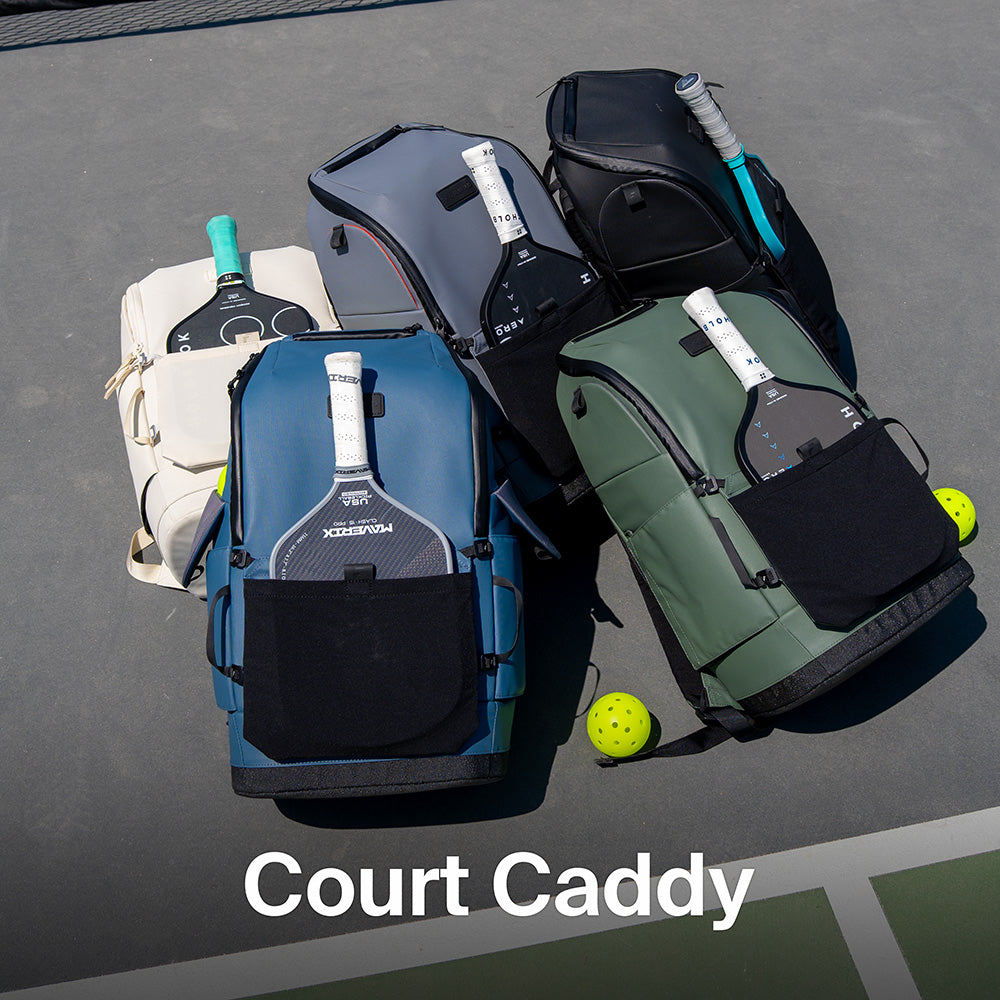
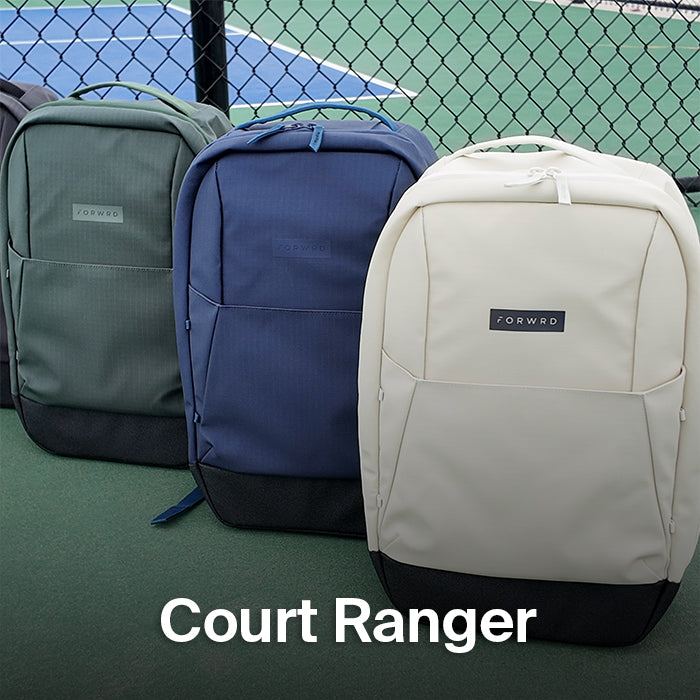
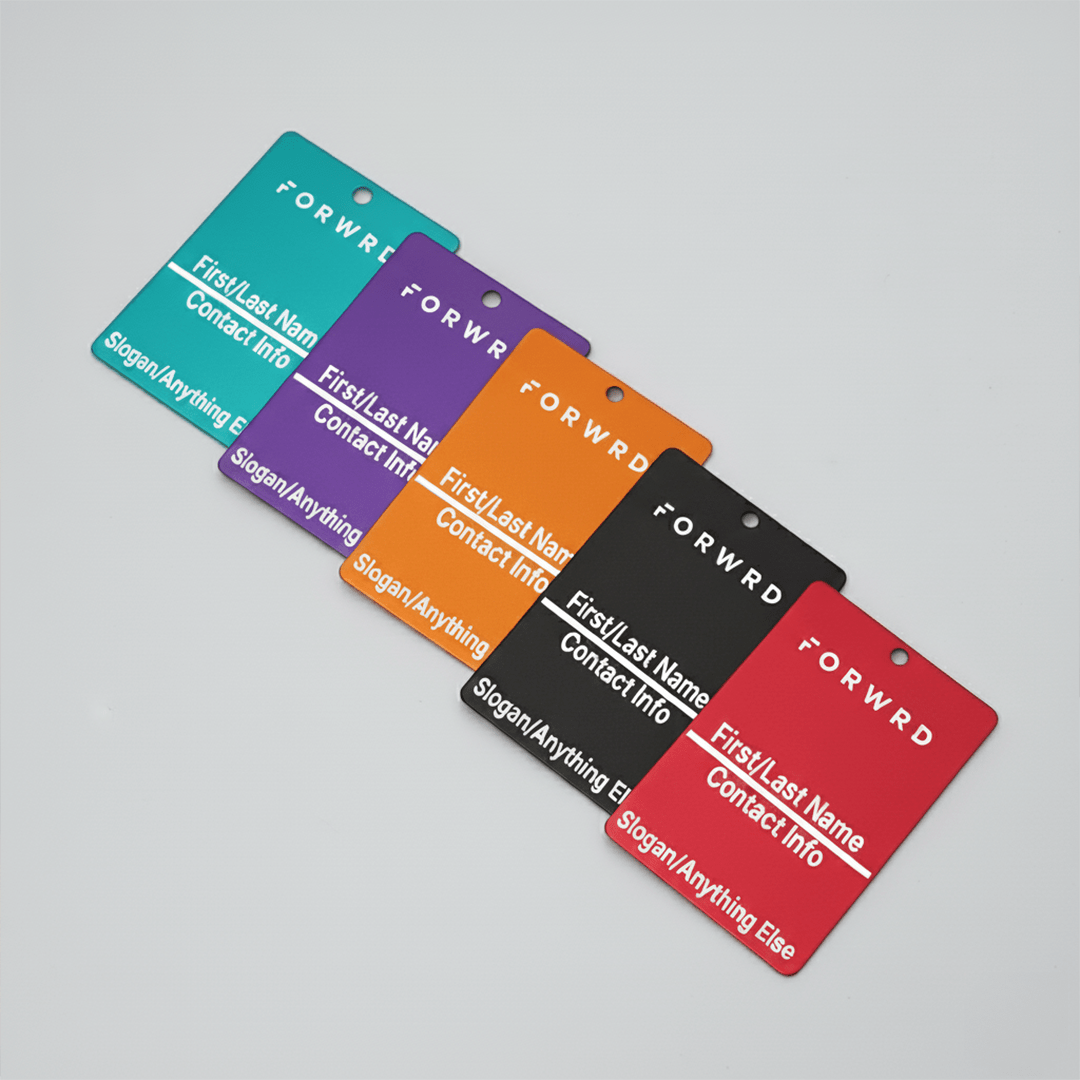
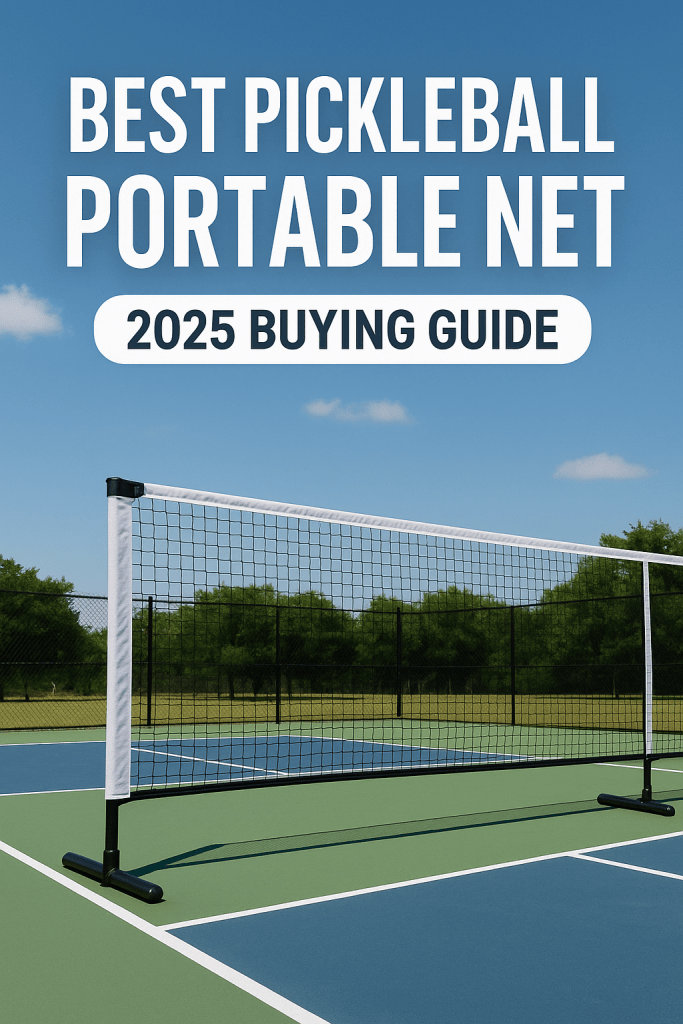
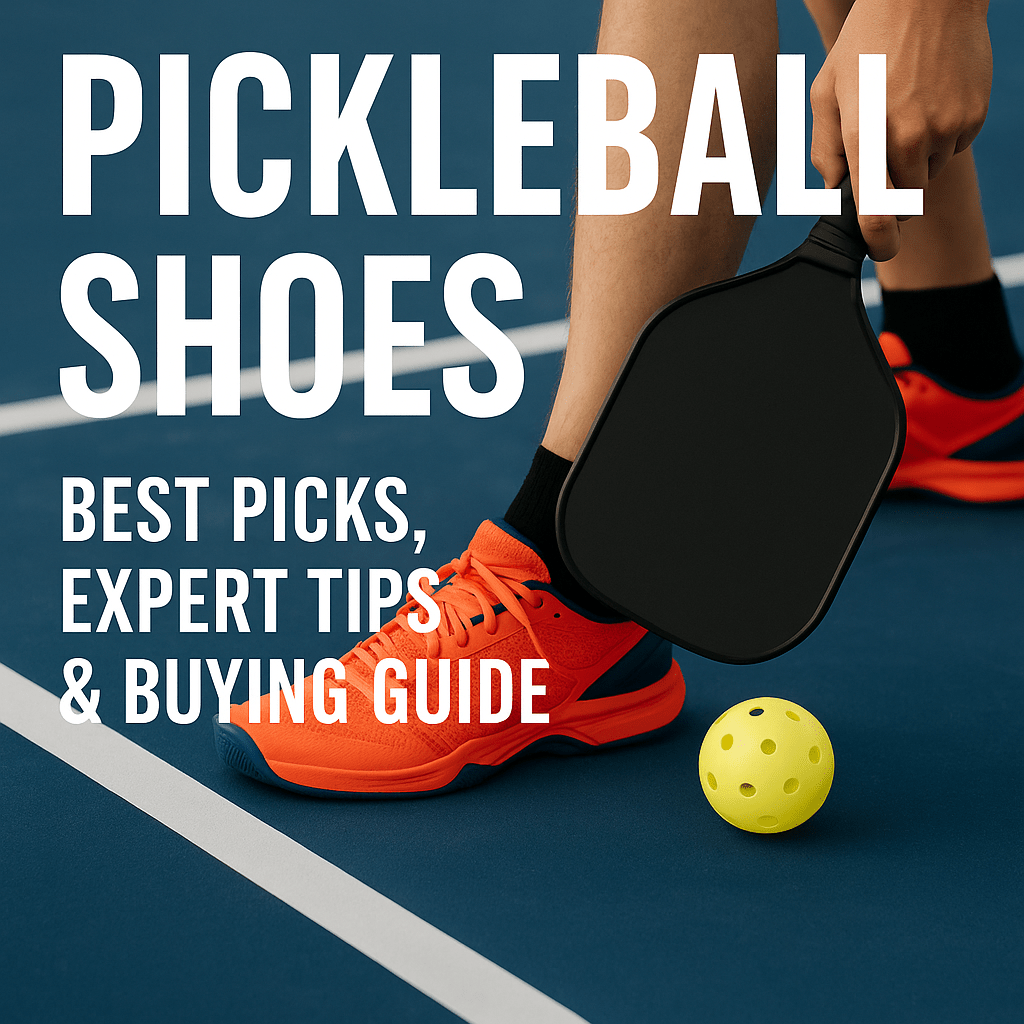
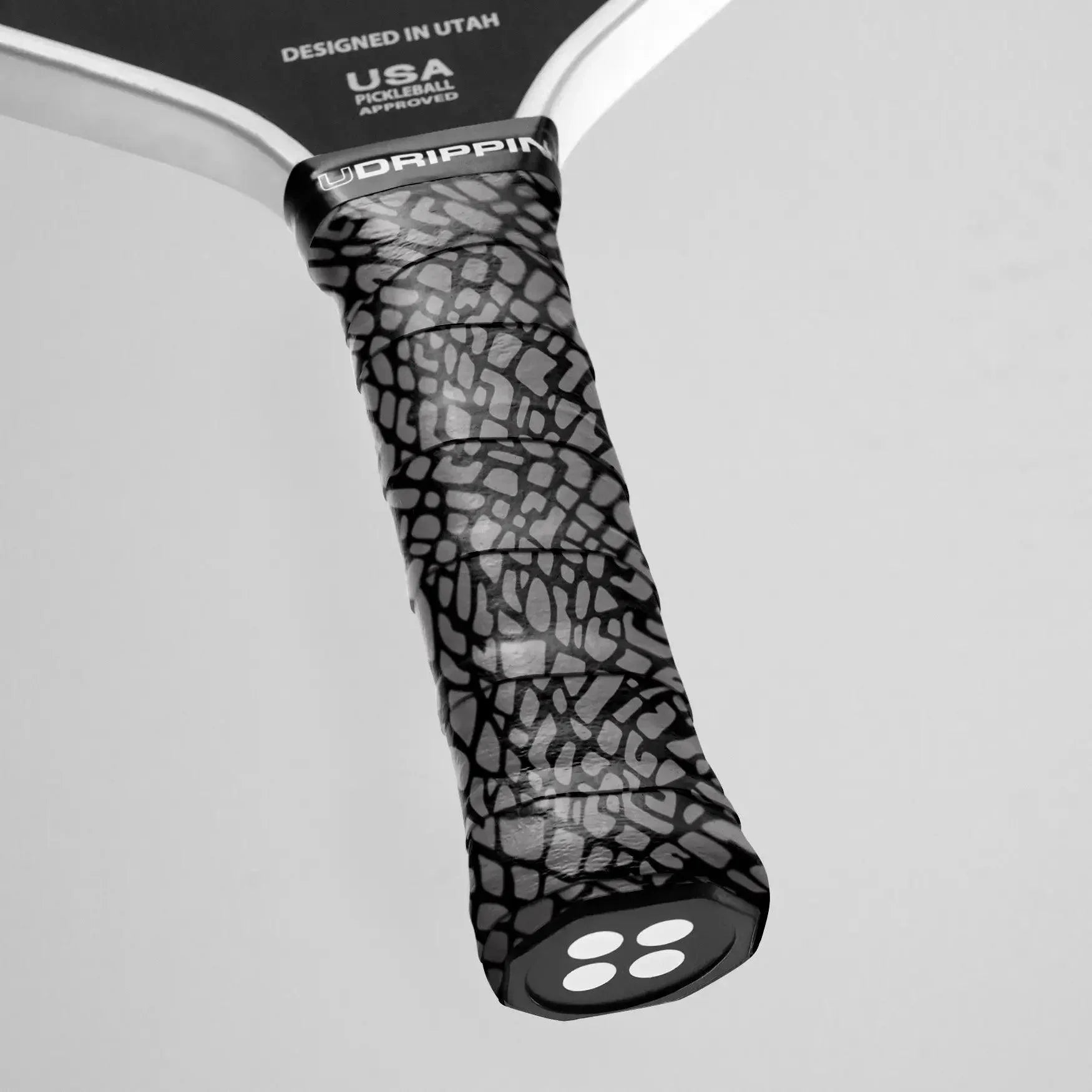
Leave a comment
All comments are moderated before being published.
This site is protected by hCaptcha and the hCaptcha Privacy Policy and Terms of Service apply.